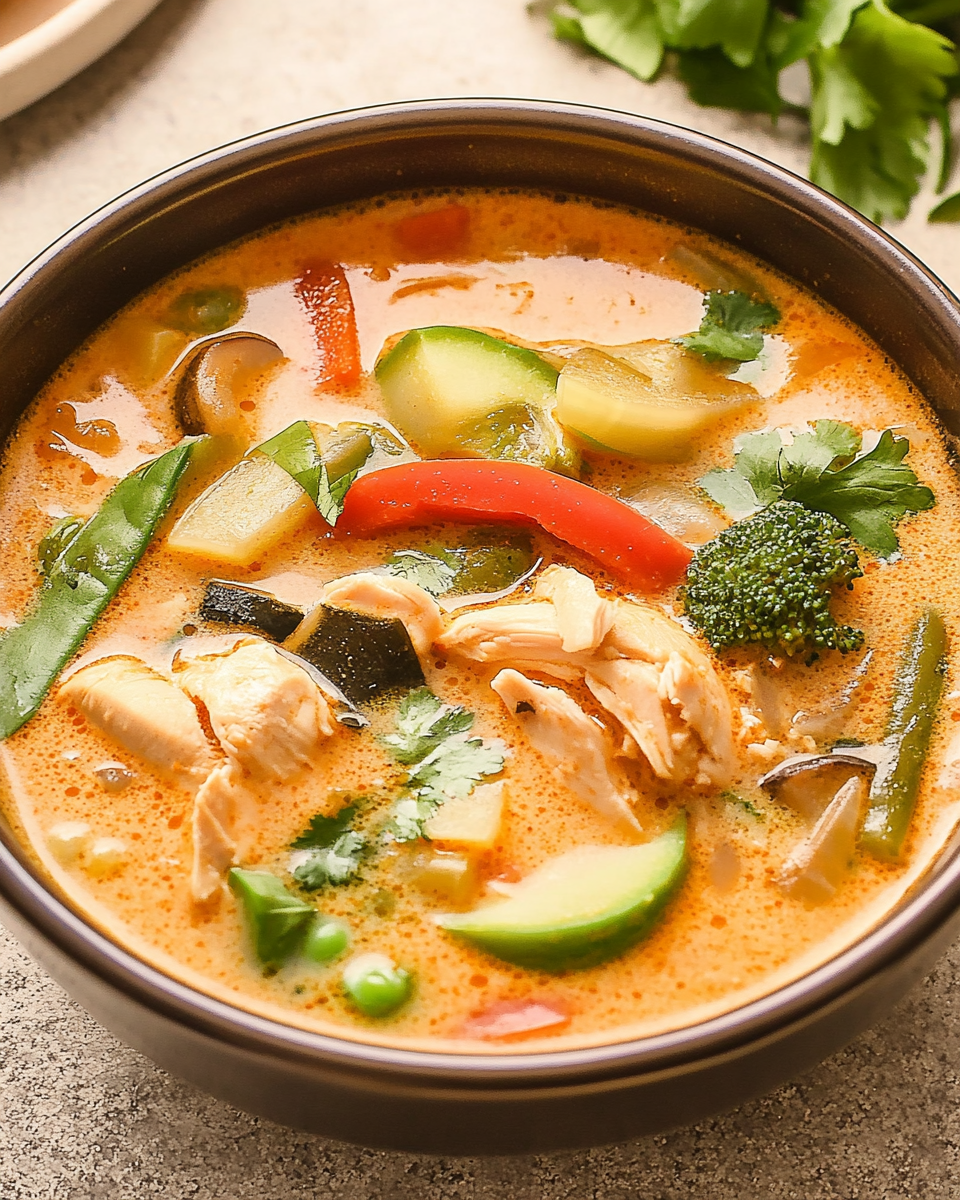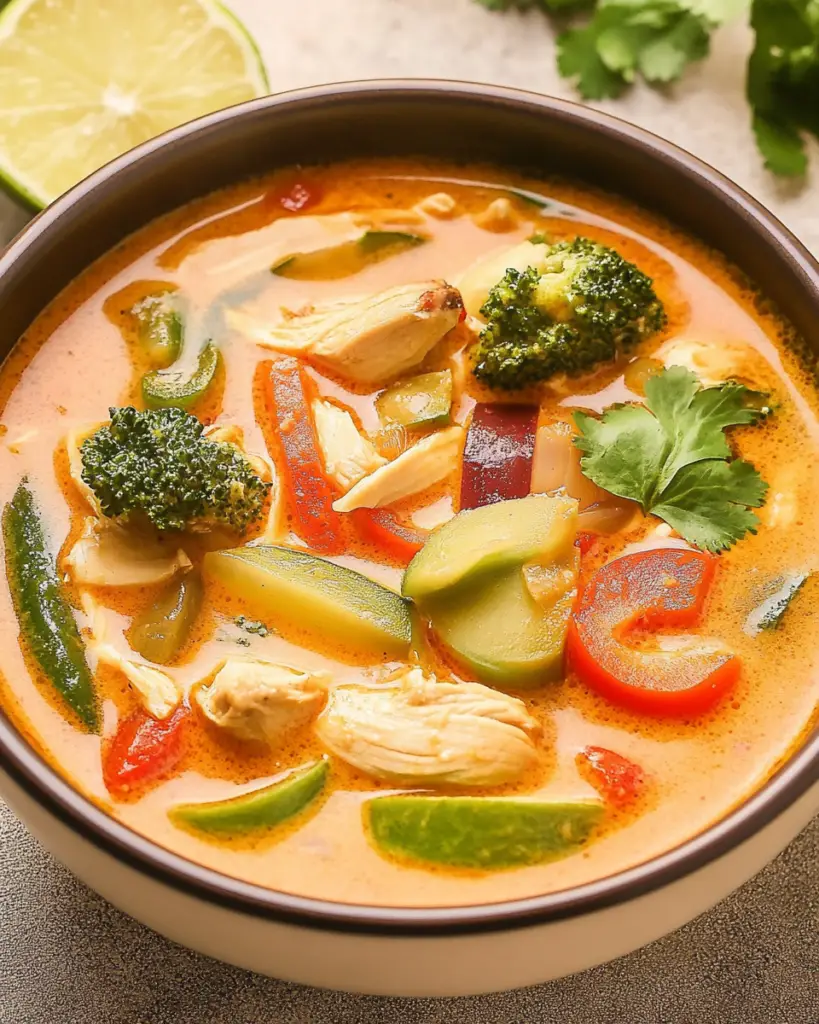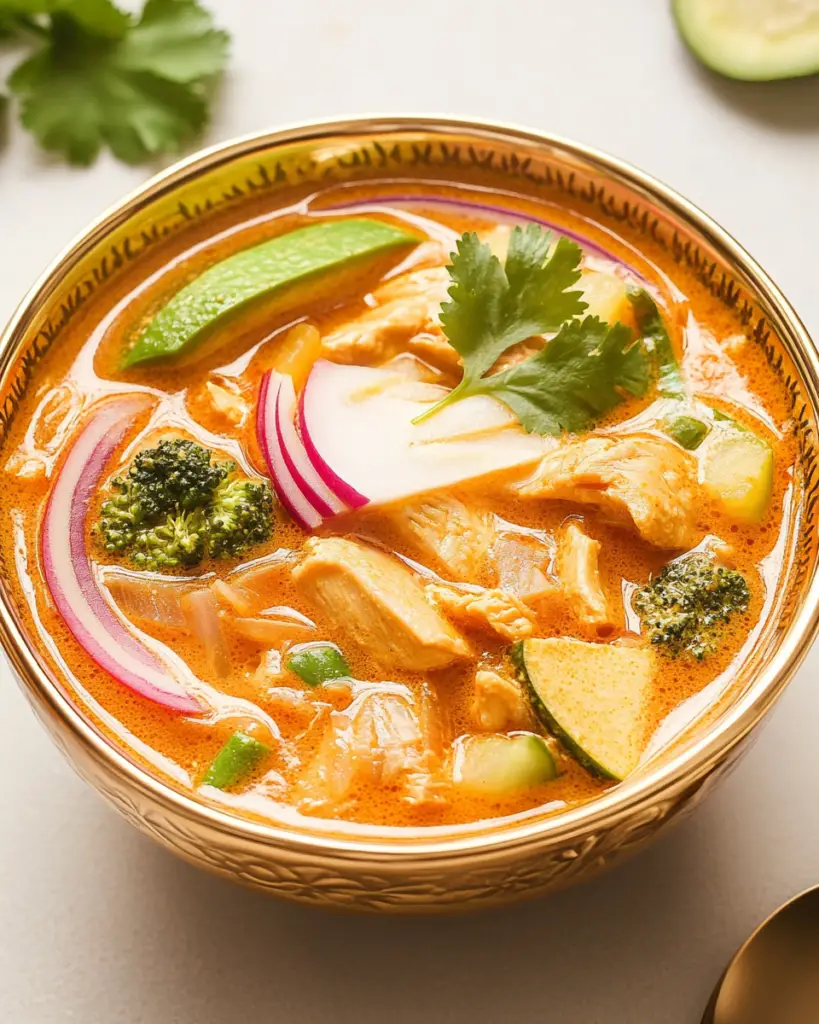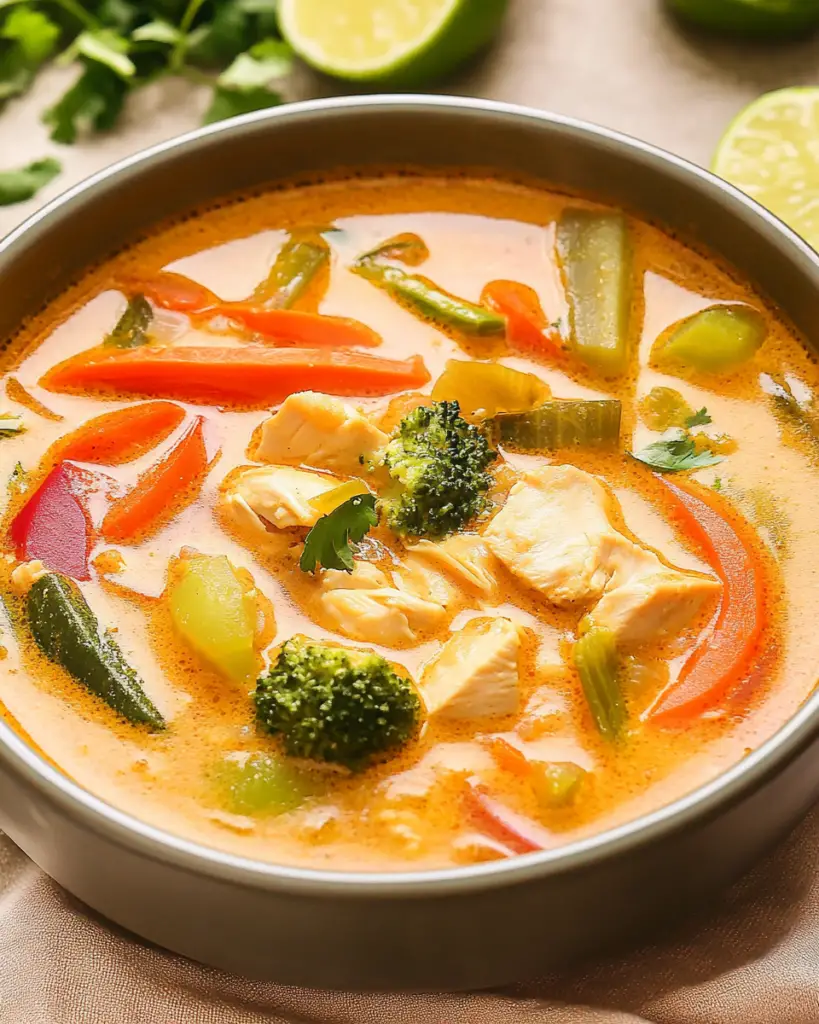This Thai Coconut Curry Chicken Soup is everything a comforting soup should be—rich, creamy, spicy, and layered with flavor. It’s a vibrant blend of tender chicken, crisp vegetables, creamy coconut milk, and the bold kick of red curry paste. Best of all, it’s naturally dairy-free, gluten-free, Whole30, and paleo-friendly, making it a perfect meal for nearly every diet.

Whether you’re looking to warm up on a chilly evening or need a quick yet nourishing weeknight dinner, this one-pot meal delivers. Every spoonful is infused with fragrant spices, silky coconut broth, and fresh herbs. The balance of heat from the curry, tartness from lime, and creaminess from the coconut milk makes this a standout among homemade soups.
Why You’ll Love This Thai Coconut Curry Chicken Soup
This soup isn’t just delicious—it’s incredibly practical. Here’s why it deserves a spot in your regular rotation:
- Dairy-Free and Gluten-Free: Naturally free of dairy and gluten, with no need for substitutions.
- One-Pot Simplicity: Everything cooks in one pot, making cleanup easy and minimal.
- Meal-Prep Friendly: Stores well and the flavors deepen over time, making it ideal for leftovers.
- Versatile: Easily swap the vegetables or protein based on what you have on hand.
- Whole30 and Paleo Compliant: With simple, whole-food ingredients.
The broth alone—velvety from coconut milk and vibrant from curry paste—is worth making this dish. It feels indulgent while remaining light and nourishing.
Preparation Phase and Tools to Use
Before you start cooking, it helps to prep all your ingredients in advance. Thai recipes often come together quickly, so having everything chopped and measured makes the process smoother.
Tools You’ll Need
- Large soup pot or Dutch oven: Ideal for even heat and volume.
- Chef’s knife: To chop vegetables and dice chicken evenly.
- Cutting board: Use separate ones for meat and vegetables to avoid cross-contamination.
- Measuring cups and spoons: Precision matters with strong flavors like curry.
- Wooden spoon or spatula: Useful for stirring and scraping bits from the bottom of the pan.
- Zester or microplane: Optional, but helpful for grating fresh ginger.
Why Each Tool Matters
Every tool has a purpose. A heavy-bottomed soup pot prevents scorching when sautéing aromatics. A sharp knife ensures clean cuts through chicken and vegetables, helping them cook evenly. Measuring tools prevent overseasoning, which is crucial when using bold ingredients like red curry paste or coconut aminos.
Preparation Tips for the Best Results
- Cut vegetables uniformly: Even slicing ensures they cook at the same rate.
- Use fresh ginger and garlic: These aromatics are key to the base flavor.
- Bloom the curry paste: Letting the paste sauté in oil before adding liquids brings out its full flavor.
- Do not overcook the chicken: Small, bite-sized pieces cook quickly and stay tender if timed right.
- Add lime juice at the end: Keeps the flavor bright and prevents bitterness.
Ingredients List (Organized and Clear)
Here’s everything you need to make this dairy-free Thai coconut curry soup:
Main Ingredients
- 2 tablespoons avocado oil or toasted sesame oil
- ½ medium onion, thinly sliced or chopped
- 3 cloves garlic, chopped
- 1 teaspoon fresh ginger, grated or finely chopped
- ¼ cup red curry paste (or green curry paste)
- 1 red bell pepper, thinly sliced
- 2 carrots, thinly sliced
- 1 medium zucchini, halved and sliced
- 4 cups chicken broth (preferably low sodium)
- 1 (13.5 oz) can full-fat coconut milk
- 3 tablespoons coconut aminos
- 1 pound chicken breast, cut into bite-sized pieces
- 2 cups broccoli florets
- 1 teaspoon salt, or to taste
- Juice of 1 lime
Garnish Options (Optional)
- Fresh cilantro or basil
- Red or green onions, thinly sliced
- Chili oil
- Chopped cashews
- Extra lime wedges
Step-by-Step Instructions
- Sauté Aromatics
In a large soup pot, heat oil over medium heat. Add onion, garlic, and ginger. Cook for about 2 minutes, stirring, until the onion softens and the garlic becomes fragrant. - Add Curry Paste
Stir in the red curry paste and cook for 1 minute. This step helps release the full flavor of the spices. - Cook the Vegetables
Add bell pepper, carrots, and zucchini. Stir to coat them in the curry mixture and sauté for 3 to 4 minutes, just until slightly softened. - Add the Liquids
Pour in chicken broth, coconut milk, and coconut aminos. Increase heat to bring the soup to a gentle simmer. - Simmer Chicken and Broccoli
Stir in diced chicken breast and broccoli florets. Simmer uncovered for 5 to 6 minutes, or until the chicken is fully cooked and the broccoli is tender but still bright green. - Finish and Serve
Add lime juice and salt to taste. Adjust seasoning as needed. Ladle into bowls and top with your preferred garnishes.
This soup is rich in flavor, easy to make, and perfect for customizing. Whether you’re on a specific diet or just love big, bold flavors, Thai Coconut Curry Chicken Soup checks all the boxes.
Serving Suggestions
When serving Thai Coconut Curry Chicken Soup (Dairy Free), the goal is to enhance its rich, creamy, and aromatic profile with thoughtful accompaniments and garnishes. Presentation matters, but so does texture and balance. This soup is already a flavor powerhouse, so the way it’s served can either elevate or dull the experience.
Here’s how to bring it to the table in the most appealing way:
- Use deep bowls: The soup is broth-based and full of vegetables and chicken, so a wide, deep bowl helps keep everything together and piping hot.
- Top strategically: Add fresh herbs like cilantro or Thai basil just before serving to preserve their aroma. Sprinkle chopped cashews or drizzle chili oil for texture and heat.
- Offer lime wedges on the side: Some may prefer extra acidity to cut the richness of the coconut milk.
- Pair with rice or noodles: Though optional, a scoop of jasmine rice or a side of rice noodles can turn the soup into a complete, satisfying meal.
- Serve with warm bowls: Pre-warming your bowls helps maintain the soup’s heat longer, especially in colder seasons.
This dish doesn’t just nourish—it also makes an impression at the table. Whether you’re serving one or four, a thoughtful garnish and a simple side will elevate the experience.

Common Mistakes to Avoid
Making Thai Coconut Curry Chicken Soup (Dairy Free) is straightforward, but there are a few mistakes that can compromise flavor and texture. Avoiding these common pitfalls will ensure a smooth and delicious cooking experience.
Overcooking the Chicken
Chicken breast cooks quickly, especially when diced. Boiling it too long can result in a rubbery texture. Instead, simmer gently and remove from heat once it’s cooked through.
Adding Lime Juice Too Early
Lime juice adds acidity, but cooking it for too long can dull its brightness and create bitterness. Always add citrus at the end of cooking, just before serving.
Using Low-Fat Coconut Milk
This recipe relies on the richness of full-fat coconut milk for its signature texture and flavor. Low-fat or light versions produce a thinner broth and lack creaminess.
Skipping the Curry Paste Bloom
Curry paste needs to be sautéed in oil for at least a minute before adding liquids. This step unlocks its full flavor and ensures the spices meld into the broth.
Overcrowding the Pot with Vegetables
Adding too many vegetables at once can lower the pot’s temperature and affect the sautéing process. Cook vegetables in batches if needed, or ensure your pot is large enough.
Undersalting the Broth
Coconut milk and chicken broth can mellow the flavors. Always taste and adjust the seasoning at the end to avoid a flat or bland soup.
Avoiding these mistakes keeps the soup vibrant, creamy, and well-balanced—exactly what you want from a Thai-inspired dish.
Side Dish Recommendations
Though Thai Coconut Curry Chicken Soup (Dairy Free) stands on its own, it pairs beautifully with a range of sides that complement its spice, richness, and texture. Here are eight side dish options to round out your meal:
1. Thai Jasmine Rice
Light and fluffy jasmine rice is a perfect base or side. It soaks up the broth and balances the soup’s bold flavors without overpowering them.
2. Cauliflower Rice
For a grain-free, low-carb option, serve with cauliflower rice. It adds bulk without the starch and keeps the dish Whole30 and paleo-friendly.
3. Fresh Spring Rolls
Packed with veggies and served with a tangy dipping sauce, spring rolls provide a crisp contrast to the warm soup. Choose gluten-free wrappers to keep it compliant.
4. Thai Cucumber Salad
This refreshing side dish features sliced cucumber, rice vinegar, and a touch of chili. It cools the palate and balances the soup’s heat.
5. Roasted Green Beans with Garlic and Chili
Crisp green beans roasted in avocado oil with garlic and red pepper flakes make a flavorful, crunchy side that pairs well with the creamy broth.
6. Stir-Fried Bok Choy
Quickly sautéed in sesame oil and finished with coconut aminos, bok choy is a nutrient-dense, Asian-inspired side that brings freshness and bite.
7. Sweet Potato Wedges with Thai Seasoning
Roasted sweet potato wedges dusted with chili, lime zest, and sea salt offer a sweet-savory combo that complements the soup’s warmth.
8. Mango Sticky Rice (for dessert)
While not a side, this Thai classic is a natural follow-up. Creamy coconut rice with ripe mango balances spice with sweetness and completes the meal.
Each side dish offers a unique texture or flavor component that complements the soup. Choose based on your dietary needs or what you have available, but all of them work well.

Recipe Tips for Success
Perfecting Thai Coconut Curry Chicken Soup (Dairy Free) is easy when you follow a few key strategies. These expert tips help enhance flavor, simplify preparation, and make the most of every bowl.
Use High-Quality Coconut Milk
The richness of this soup relies heavily on full-fat coconut milk. Choose a brand with minimal additives and no added sugar for the cleanest taste and smoothest texture. Avoid light versions, which water down the broth and reduce creaminess.
Always Bloom the Curry Paste
One of the most critical flavor-building steps is blooming the curry paste in hot oil before adding any liquids. This process activates the spices and intensifies the depth of flavor. Skipping this step can result in a flat-tasting broth.
Prep Ingredients Before You Begin
Thai cooking often moves quickly. Having your vegetables chopped, chicken diced, and liquids measured ahead of time ensures a smooth cooking process and better results.
Balance Your Flavors
Thai cuisine is all about balance: spicy, sweet, sour, and salty. Adjust these elements by tasting as you go. A splash of extra lime juice or coconut aminos can dramatically shift the profile and elevate the dish.
Customize the Protein and Vegetables
This soup is adaptable. Substitute shrimp, tofu, or even leftover rotisserie chicken. Switch out vegetables based on season or availability. Snow peas, mushrooms, and spinach all work beautifully in place of or alongside the listed ingredients.
Storage Instructions
Thai Coconut Curry Chicken Soup (Dairy Free) stores exceptionally well, making it ideal for meal prep or leftovers.
- Refrigerator: Store in an airtight container for up to 5 days. Let the soup cool to room temperature before sealing to prevent condensation.
- Separate Garnishes: Keep fresh herbs, chili oil, and lime wedges separate until serving to preserve texture and flavor.
- Avoid Storing in Metal: Use glass or BPA-free plastic containers to prevent the acidic lime juice from reacting with metal surfaces.
Reheating Instructions
Maintaining the soup’s flavor and texture during reheating is simple with the right method.
On the Stove
- Pour soup into a small saucepan and reheat over medium heat.
- Stir occasionally and heat until just warmed through—do not let it boil vigorously, as this can affect the texture of the chicken and coconut milk.
In the Microwave
- Place a portion in a microwave-safe bowl and cover loosely.
- Heat in 30-second intervals, stirring in between, until hot.
- Add fresh garnishes after reheating for the best flavor.
Freezing is also an option, though some vegetables may soften slightly during thawing. For best results, freeze without garnishes and reheat gently.

Frequently Asked Questions
Is this soup spicy?
It has a moderate level of spice, thanks to the red curry paste. To make it milder, reduce the amount of curry paste or choose a mild variety. You can also add more coconut milk to soften the heat.
Can I make it vegetarian or vegan?
Yes. Swap the chicken for tofu or chickpeas and use vegetable broth instead of chicken broth. Ensure your curry paste is vegan, as some contain shrimp paste.
Can I use green curry paste?
Absolutely. Green curry paste offers a different flavor profile—more herbal and slightly more pungent—but works well in this soup. Just substitute it one-for-one in the recipe.
What vegetables can I substitute?
Nearly any quick-cooking vegetable works. Try mushrooms, baby spinach, kale, snow peas, or baby corn. Use what’s in season or what you have on hand.
Does this soup freeze well?
Yes. The soup freezes beautifully for up to 2 months. Freeze in individual portions for convenience. Thaw overnight in the fridge before reheating.
Is this recipe Whole30 compliant?
It is, as long as you use Whole30-approved ingredients. Double-check your curry paste, chicken broth, and coconut aminos to ensure they contain no added sugars or soy.
Conclusion
Thai Coconut Curry Chicken Soup (Dairy Free) is more than just a comforting meal—it’s a bold, aromatic dish that brings together vibrant Thai flavors with wholesome, nourishing ingredients. It’s easy to prepare, customizable, and fits into a variety of dietary lifestyles including Whole30, paleo, gluten-free, and dairy-free.
With its creamy coconut broth, tender chicken, and bright pops of lime and herbs, this soup satisfies on every level. It’s perfect for a quick weeknight dinner, a healthy lunch prep, or a flavorful way to warm up on a cold day.
Once you make it, it’s likely to become a staple in your rotation. From its fast prep to its restaurant-worthy flavor, this is a recipe that proves comfort food can be both clean and craveable.
Thai Coconut Curry Chicken Soup (Dairy Free)
Ingredients
- 2 tablespoons avocado oil or toasted sesame oil
- 1/2 medium onion thinly sliced or chopped
- 3 cloves garlic chopped
- 1 teaspoon fresh ginger grated or finely chopped
- 1/4 cup red curry paste or green curry paste
- 1 red bell pepper thinly sliced
- 2 carrots thinly sliced
- 1 medium zucchini halved lengthwise and sliced
- 4 cups chicken broth low sodium preferred
- 1 13.5 oz can full-fat coconut milk
- 3 tablespoons coconut aminos
- 1 pound chicken breast cut into bite-sized pieces
- 2 cups broccoli florets
- 1 teaspoon salt or to taste
- Juice of 1 lime
For Garnish (optional):
- Fresh cilantro or basil
- Red or green onions thinly sliced
- Chili oil
- Chopped cashews
- Extra lime wedges
Instructions
- Sauté aromatics: In a large soup pot, heat oil over medium heat. Add the onion, garlic, and ginger. Cook for about 2 minutes, stirring, until onions soften and garlic is fragrant.
- Add curry paste: Stir in the curry paste and cook for 1 minute, allowing it to bloom and coat the aromatics.
- Cook the veggies: Add bell pepper, carrots, and zucchini. Stir to coat in curry mixture and sauté for 3–4 minutes, until slightly softened.
- Add liquids: Pour in the chicken broth, coconut milk, and coconut aminos. Increase heat to medium-high and bring to a gentle simmer.
- Add chicken and broccoli: Stir in the chicken breast and broccoli florets. Simmer for 5–6 minutes, or until chicken is fully cooked and broccoli is bright green and tender.
- Season and finish: Stir in lime juice and salt to taste. Adjust seasoning as needed.
- Serve: Ladle into bowls and garnish with fresh herbs, onions, chili oil, cashews, and lime wedges as desired.






Leave a Comment